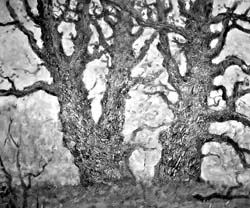Three world views
The Artist’s House hosts exposition of original artists from Kharkiv, Kyiv, and Dnipropetrovsk
Kharkiv’s artist Valentyna Safina brought a number of landscapes from her travels, although this geography is rather conventional and is felt in the true sense of the word only in titles (e.g., At Vynohradna. Ai-Vasyl, Darvyna after Rain, At Repin’s Estate). Mostly it does not matter where Valentyna Safina gets her inspiration which she determines as After Rain, Spring. A Roman Catholic Cathedral, Mallows or Umbrellas. The Kharkiv artist’s landscapes are very frank, in other words subjective. There are no “peeping” heroes. Rather, their main hero is the Kharkiv artist, her soul, mood, her ability to perceive the surrounding world, marvel at it and transform it.
Andrii Heta’s life can be actually summed up as serving his most cherished dream of becoming an artist. His one-man show is quite extensive, occupying several halls at the Artist’s House. The exposition is made up of works created over sixty years. They are diversified not only in terms of technique and genre, but also each canvas’s history, ranging from WW II sketches (he took part in the war) to landscapes brimming with colors and light.
The display is dominated by landscapes, including urban ones (e.g., Kyiv. Tatarka), lyrical studies (Winter Twilight, Naked Trees, Blossoming Yard), and philosophical reflections (Giant Oaks). An unquenchable thirst for fresh impressions is probably the predominant feature of Andrii Heta’s creativity. It is as though nothing in the world can leave the artist indifferent. He has a remarkable range of occupations and interests, including artistic projection, design, architecture. The exposition includes photos of monuments and memorial plaques done by him in collaboration with Vasyl Miroshnychenko, also his tapestries that are laconically decorative, demonstrating interesting techniques involving color as well as material (Winter Landscape, Evening Colors, The Road to the Temple, The Sea).
Watercolors, however, are predominant. Many of these are perfectly “self-sufficient” (Red Flowers, Tiflis), although most of them were created as large series (The Year 1941, In Karelia) and this does not diminish the expressiveness, at times a piercing message of each composition (Wait for Me; Chapel, vil. Podielnyky). Vasyl Miroshnychenko’s watercolors are monumental, both literally and figuratively. The size is not the point (although his canvases are large indeed) but composition, colors, and subject matter.






